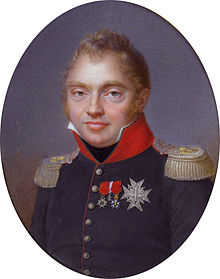Amy Brown (royal mistress)
| Amy Brown | |
|---|---|
 Portrait of Amy Brown by an unknown artist | |
| Born | 8 April 1783 Maidstone, Kent, England |
| Died | 7 May 1876 (aged 93) Chateau de La Contrie, France |
| Spouses | Mr. Freeman Charles Ferdinand, Duke of Berry |
| Issue | John Freeman Charlotte Marie Augustine de Bourbon, Comtesse d'Issoudun Louise Marie Charlotte de Bourbon, Comtesse de Vierzon |
| Father | John L. Brown |
| Mother | Mary Ann Deacon |
Amy Brown (8 April 1783 – 7 May 1876) was the English-born mistress of Charles Ferdinand, Duke of Berry, younger son of King Charles X of France and Marie Thérèse of Savoy. Some autors have stated that they married in a secret ceremony which was conducted in England by her father, a Protestant pastor, but there is no evidence of it. Together they had two daughters; however, when he returned to France, he was constrained to put an end to his relationship for reasons of state.
Early years
Amy Brown was born on 8 April 1783 in Maidstone, Kent,[1] England to John L. Brown, a Protestant pastor,[2] and Mary Ann Deacon. Sometime before 1804, she married a Mr. Freeman by whom she had a son, John Freeman, who was born on 5 December 1804. Nothing further is recorded of her husband or his subsequent fate; however, author David Skuy describes Amy as having been a widow when she first met the duke.[3] Amy's son John married French aristocrat Sophie de Blonay by whom he had issue.
The Duke of Berry
Amy met Charles Ferdinand, Duke of Berry in 1804 in London, three years after the Bourbon royal family was exiled to England. As her son had been born in December of that year, it was likely that they had first met while she was pregnant, although the exact date of their meeting is not known. Amy perhaps married Charles Ferdinand in a secret ceremony conducted by her father in 1806, without the duke having first obtained permission from his family and ignoring the fact that as a non-Catholic, no son of Amy's could ever ascend the French throne.[4] As it turned out, they did not have a son, although Amy bore the duke two daughters:[5]
- Charlotte Marie Augustine de Bourbon, Comtesse d'Issoudun (13 July 1808 – 13 July 1886) [6], married in 1823 Ferdinand de Faucigny-Lucinge, Prince of Lucinge, by whom she had issue. She is an ancestress of Anne-Aymone Giscard d'Estaing, president Valery Giscard d'Estaing's wife.
- Louise Marie Charlotte de Bourbon, Comtesse de Vierzon (29 December 1809 – 26 December 1891), married in 1827 Charles de Charette de La Contrie, Baron de La Contrie, by whom she had issue. She is an ancestress of French minister Hervé de Charette.
After receiving the news of Napoleon's abdication, the duke returned to France in 1814, taking his daughters with him. Amy remained behind in England. Upon his return, he was constrained to separate Amy for political reasons. If it was real, the marriage was declared invalid due to the lack of royal consent to the match, and therefore the official position was that Amy had never been his wife at all but rather his mistress.[7] He subsequently married Caroline Ferdinande Louise (5 November 1798 – 17 April 1870), eldest daughter of King Francis I of the Two Sicilies by whom he had four children, including Henri, Comte de Chambord, Legitimist Pretender to the throne of France. He also fathered two illegitimate sons by dancer Eugénie-Virginie Oreille (8 August 1795 – October 1875), who was one of his many mistresses. The duke was assassinated by a saddler, Louis Pierre Louvel on 14 February 1820; while he lay dying, the duke asked to see Amy and his daughters, entrusting them to the care of his wife, who afterwards adopted the two girls.[8]
Death and legacy
Amy's son by her first marriage, John Freeman died 26 August 1866 in Zurich, Switzerland; and Amy herself died on 7 May 1876 at the age of ninety-three at the Chateau de La Contrie, France. Through her daughter, the Baronne de Charette, Amy is the ancestress of Hervé de Charette[9] (born 30 July 1938) the French Foreign Minister from 1995–1997

Sources
- http://www.thepeerage.com.
- The French Royal Family: A Genealogy by Francois Velde.
Bibliography
- Template:Fr Jean-Jacques Boucher, Charles-Ferdinand d'Artois, Duc de Berry, Fernand Lanore, 2000
- Template:Fr André Castelot, La Duchesse de Berry, Perrin, 1996
- Transclusion error: {{En}} is only for use in File namespace. Use {{lang-en}} or {{in lang|en}} instead. David Skuy, Assassination, power, and miracles: France and the Royalist reaction of 1820, (2003), McGill-Queen's University Press, Canada, ISBN 0-7735-2457-6
See also
References
- ^ www.thePeerage.com/p.11377.htm#113764
- ^ David Skuy, Assassination, power, and miracles: France and the Royalist reaction of 1820, (2003), McGill-Queen's University Press, Canada, ISBN 0-7735-2457-6, Google Books, p.4, retrieved 4-10-10
- ^ Skuy, p.4
- ^ Skuy, p. 4
- ^ Francois Velde,The French Royal Family: A Genealogy
- ^ Charlotte de Bourbon at thePeerage.com http://www.thepeerage.com/p5912.htm#i59116
- ^ Skuy, p. 5
- ^ Skuy, p. 12
- ^ Francios Velde, The French Royal Family: A Genealogy
